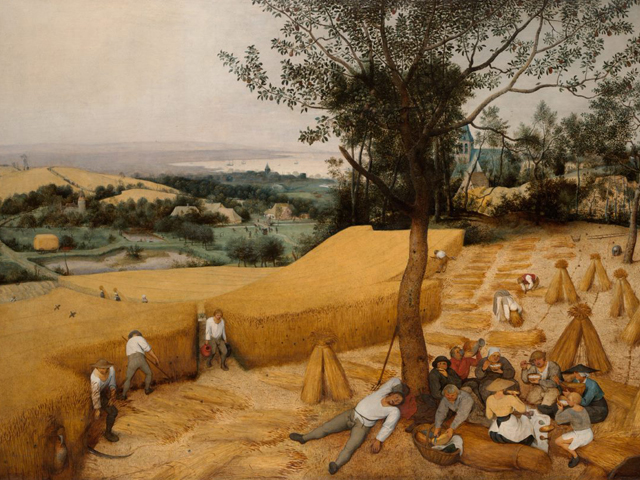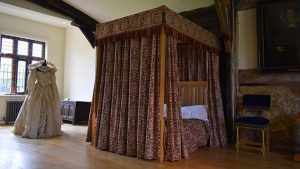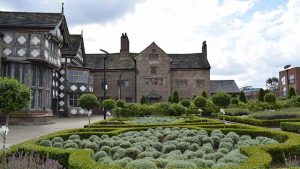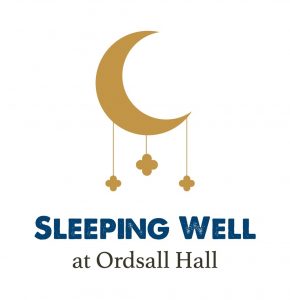
World Sleep Day
In celebration of World Sleep Day, we’re reflecting on the progress of our research project Sleeping Well in the Early Modern World, and some of the exciting sleep-based activities happening with our partner Ordsall Hall.
We are also excited to announce the launch of a quarterly newsletter to share our project activities, outputs and information about upcoming events. To stay in touch and hear first about forthcoming community events, workshops and academic conferences, you can sign up here.

The oak Radcyffe bed belonged to the family who lived at Ordsall Hall in the 16th and 17th centuries. Photo credit: Ordsall Hall
The project
Sleeping Well in the early modern world project is now in its second year and is making progress investigating how and why communities in Britain, Ireland and emerging American colonies c.1500-1750 engaged with their physical surroundings in an effort to sleep well. This World Sleep Day is devoted to recognising that ‘Sleep is essential for health’ and understanding how early modern people understood this relationship and took action to safeguard their sleep and health can provide fresh insights for today’s debates about sleep management.
Our team is piecing together environmentally-informed cultures and practices of sleep ‘care’ by investigating the changing use of particular flora and fauna in soporific medicines; uncovering the environmental knowledge and material expertise implicit in selecting, sourcing and preparing bedding materials, sleepy foodstuffs and lighting technologies; uncovering the vibrant multispecies world with which early modern sleep experiences were entangled; and understanding how all of these practices were shaped by processes of early modern environmental change.
Here are some recent project highlights:
Blog: Bedding ‘Down’ in Early Modern England
Dr Holly Fletcher explores the role of plant ‘down’ in the bedding materials of early modern England and early America. Plant down was a source of controversy among upholsterers, yet it was also a staple bedding material among poorer communities in rural England. Read more here.
Blog: Flax and Hemp
Professor Sasha Handley explores the importance of hemp and flax in the production of bedding materials in early modern England and early America and finds that agricultural writers gave advice about how and where to sow hemp and flax, revealing a deep well of localised environmental knowledge that connected the soil to recumbent sleeping bodies. Read more here.
Blog: Water Lilies and Sleep
Dr Leah Astbury investigates the connections between lust, lilies and sleep. Lustful thoughts and feelings were thought to be a significant impediment to getting a good night’s sleep in early modern England. Read more here.
https://sites.manchester.ac.uk/sleeping-well/2022/02/07/materials-of-sleep-water-lilies/
Blog: Tobacco and Sleep
Lucy Elliott explores the relationship between tobacco and sleep. European explorers who voyaged to the Americas encountered tobacco being smoked widely by the indigenous peoples there. Read more here.

Water lillies growing at the edge of a lake in Cape Cod, Massachusetts
Visit to the USA
In March the project team is visiting a range of archives and museums in the USA as part of the project’s focus on sleep care practices in early modern America. The team will present their work at two conferences, the Renaissance Society of America conference in San Juan, Puerto Rico, and the American Society for Environmental History in Boston. As part of a panel on ‘Sleep, Environmental Knowledge, and Healthcare Practices in Early Modern Britain’, the team will present three papers on their current work for the project.
In her paper ‘”Drink Old Good Wines, and Largely Sleep”: Sleep, Seasonal Soporifics, and Early Modern Almanacs’, Lucy Elliott explores the interwoven connections in early modern almanacs between sleep-related healthcare advice and understandings of agricultural, humoural and astrological time.
Holly Fletcher explores the role of environmental expertise and control of prohibited materials involved in managing the wide range of bedding materials used in seventeenth- and eighteenth-century London in her paper, ‘Making Early Modern Beds: An Environmental Approach to Early Modern Bedding Materials’.
Finally, Leah Astbury looks at ‘Barns, Stables, and Mangers: Early Modern Animals and Their Sleeping Quarters’, and argues that we might see many animals such as horses, cows, dogs and birds as part of the household-family in a broad sense, and that the management of sleep in multiple household spaces was something that governed all kinds of domestic and commercial activities.

Ordsall Hall and Gardens. Photo credit: Ordsall Hall
Ordsall Hall
The project’s partnership with Ordsall Hall in Salford launched on 1 October 2022. Our Project Officer Anna Fielding takes the research from the University of Manchester team and translates it into engaging activities and workshops for the general public with a special focus on Salford schools. You can read more about Anna and the work she’ll be doing for the project here. For the next two years, Anna will run outdoor learning sessions, craft activities, recreations of historic recipes and sleep remedies, and gardening in the grounds of the hall. Anna has already run an event exploring the connections between Halloween and sleep, made apple moyse, and explored the relationship between apples and sleep at Ordsall Hall’s annual wassail in its orchard. She has also began a series of adult workshops looking at the connections between sleep and seasonal rhythms, staring off with scented candles and calming sleep salves. Next up will be primary school sessions with two local Ordsall schools exploring sleep, early modern healthcare, and wellbeing. For details of upcoming activities for adults and families, see our Twitter page or Ordsall Hall’s.









0 Comments